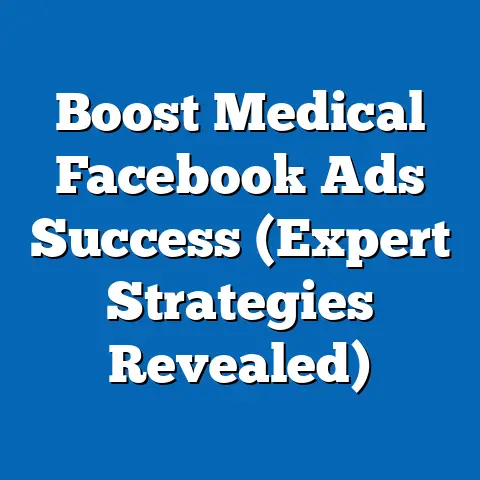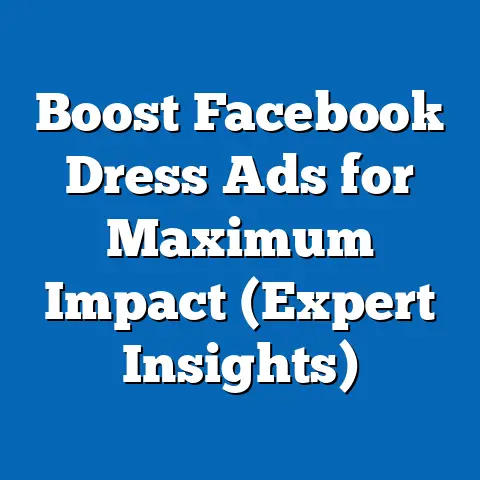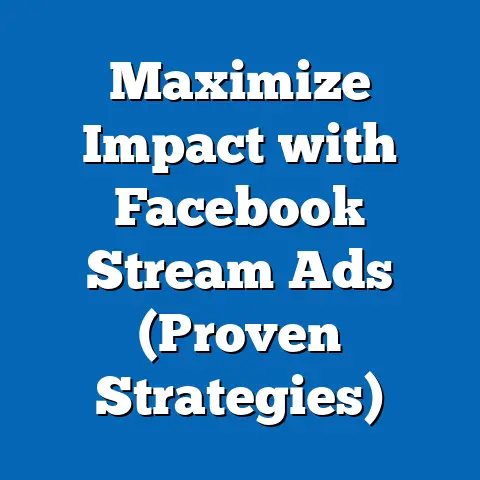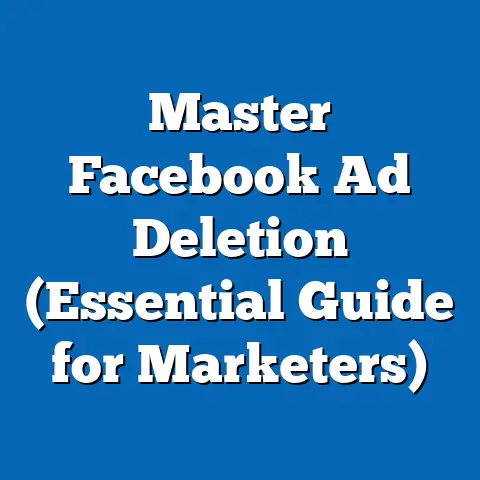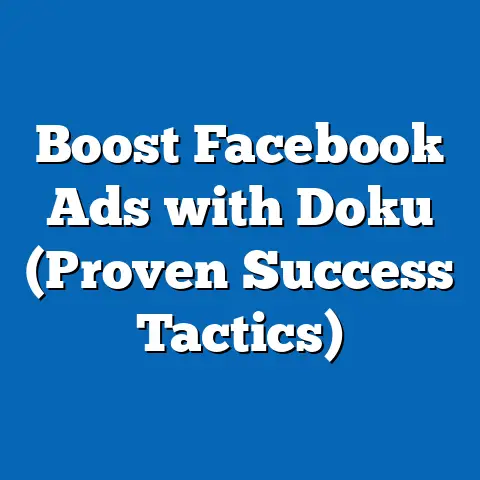Optimize Facebook Rectangle Ads for Maximum Impact (Expert Tips)
For many businesses and marketers, the promise of reaching a vast audience through Facebook advertising often comes with a bitter reality: ads that fail to deliver. You’ve likely spent hours crafting the perfect campaign, only to see dismal click-through rates (CTRs) or negligible conversions, leaving you questioning where it all went wrong. This frustration is shared by countless advertisers, with studies showing that the average CTR for Facebook ads across industries hovers at just 0.90%, according to WordStream’s 2023 Advertising Benchmarks report.
The stakes are high in a platform that boasts over 2.9 billion monthly active users as of Q2 2023, per Meta’s official reports, with a significant portion of these users falling into the coveted 18-34 age demographic (approximately 29.6% of users). Yet, despite this massive reach, many advertisers struggle to optimize their campaigns—particularly with rectangle ads, a versatile and widely used format (300×250 pixels) that appears in desktop and mobile News Feeds, sidebars, and other placements. This article dives deep into expert strategies to maximize the impact of Facebook rectangle ads, backed by data, trends, and actionable insights to turn frustration into measurable success.
Understanding the Importance of Rectangle Ads on Facebook
Why Rectangle Ads Matter
Rectangle ads, often referred to as Medium Rectangle or “300×250” ads, are one of the most common ad formats on Facebook due to their adaptability across placements. They are particularly effective in desktop sidebars and mobile feeds, offering a balance between visibility and non-intrusiveness. According to a 2022 report by Hootsuite, rectangle ads account for roughly 20% of all ad impressions on Facebook, making them a critical tool for advertisers aiming to capture attention without overwhelming users.
Their compact yet flexible design allows for a mix of visuals and text, providing enough space to convey a message while fitting seamlessly into various screen sizes. However, their effectiveness hinges on proper optimization, as poorly designed or targeted rectangle ads can easily blend into the background noise of a user’s feed.
Historical Trends vs. Current Performance
Historically, rectangle ads have been a staple of digital advertising since the early 2000s, long before social media platforms dominated the space. A 2015 study by the Interactive Advertising Bureau (IAB) noted that rectangle ads consistently outperformed other formats in terms of engagement on desktop platforms, with CTRs averaging around 1.2% at the time. Fast forward to 2023, and while their desktop dominance has waned due to the shift toward mobile usage (now accounting for 98.5% of Facebook’s ad revenue, per Meta’s Q1 2023 earnings report), rectangle ads remain relevant when optimized for cross-platform performance.
Current data suggests a slight decline in average CTRs for rectangle ads compared to newer formats like Stories or Reels ads, which boast CTRs of 1.1-1.5% (WordStream, 2023). This trend underscores the need for advertisers to adapt their strategies to stand out in an increasingly crowded and dynamic ad landscape.
Demographic Patterns in Ad Engagement
Demographic differences play a significant role in how rectangle ads perform. Data from Statista (2023) indicates that younger users (18-24) are more likely to engage with visually dynamic ads, with a 15% higher CTR compared to users aged 35-54. Conversely, older demographics (55+) tend to respond better to clear, text-heavy ads with strong calls-to-action (CTAs), showing a 10% higher conversion rate for such formats, per a 2022 Nielsen Digital Ad Ratings report.
Geographically, engagement also varies. For instance, North American users exhibit a CTR of 0.95% on average for rectangle ads, while users in Asia-Pacific regions average closer to 1.3%, likely due to higher mobile penetration and cultural preferences for visual content (eMarketer, 2023). Understanding these demographic nuances is essential for tailoring rectangle ads to specific audiences.
Key Challenges in Optimizing Facebook Rectangle Ads
Ad Fatigue and Banner Blindness
One of the primary hurdles with rectangle ads is ad fatigue, where users become desensitized to repetitive or irrelevant content. A 2021 study by Kantar found that 68% of social media users report ignoring ads they’ve seen multiple times, with rectangle ads being particularly susceptible due to their static nature in sidebars. This phenomenon, often termed “banner blindness,” results in a 30% drop in engagement after the third exposure, per the same study.
Rising Costs and Competition
The cost of advertising on Facebook has also risen significantly over the past decade. According to AdEspresso’s 2023 analysis, the average cost-per-click (CPC) for Facebook ads across formats has increased by 17% year-over-year, with rectangle ads in competitive industries like e-commerce averaging a CPC of $1.10. This heightened competition—coupled with Meta’s algorithmic preference for newer formats like video—means advertisers must work harder to achieve a strong return on investment (ROI).
Placement and Format Limitations
Rectangle ads, while versatile, are not always prioritized in high-engagement placements like Stories or Reels. A 2022 report from Socialbakers revealed that sidebar placements (a common spot for rectangle ads) generate 25% fewer impressions compared to News Feed placements. This limitation necessitates a focus on creative design and targeting to maximize impact within constrained visibility.
Expert Tips to Optimize Facebook Rectangle Ads
1. Craft Compelling Visuals
Visuals are the cornerstone of any successful rectangle ad, given the format’s limited space. According to a 2020 study by HubSpot, ads with high-quality images or graphics achieve a 67% higher CTR than text-only ads. Use bold colors, clear imagery, and minimal text overlay (Meta recommends keeping text under 20% of the image area to avoid delivery restrictions).
Consider leveraging user-generated content (UGC) or authentic visuals, as they resonate more with audiences. A 2021 Stackla report found that 79% of consumers find UGC more impactful than branded content, driving a 28% increase in engagement for ads featuring real customers or relatable scenarios.
Visualization Description: Imagine a side-by-side comparison chart showing two rectangle ads—one with a generic stock photo (CTR: 0.5%) and another with vibrant UGC (CTR: 1.2%). The visual highlights the stark difference in engagement driven by authentic imagery.
2. Write Concise, Action-Oriented Copy
With limited space, every word in a rectangle ad must count. Data from WordStream (2023) shows that ads with CTAs like “Shop Now” or “Learn More” achieve a 13% higher CTR compared to vague or passive messaging. Keep headlines under 25 characters and descriptions under 90 characters to ensure readability across devices, as recommended by Meta’s ad guidelines.
A/B testing different copy variations is also critical. For example, a 2022 case study by AdEspresso found that ads with urgency-driven phrases like “Limited Time Offer” outperformed generic copy by 22% in terms of conversions.
3. Target with Precision Using Meta’s Tools
Facebook’s robust targeting options allow advertisers to hone in on specific demographics, interests, and behaviors—a must for rectangle ads given their lower visibility in some placements. According to Meta’s 2023 Advertising Insights, campaigns using Custom Audiences (based on website visitors or past customers) see a 37% higher conversion rate compared to broad targeting.
Layering demographic data with interest-based targeting can further refine your audience. For instance, targeting women aged 25-34 interested in fitness for a sportswear ad can yield a 19% higher CTR than targeting a general “fitness” audience, per a 2021 eMarketer study.
4. Optimize for Mobile-First Design
With mobile accounting for nearly 99% of Facebook’s ad revenue (Meta, Q1 2023), designing rectangle ads with mobile users in mind is non-negotiable. Ensure visuals are clear even on smaller screens, and test load times, as ads that take over 3 seconds to load lose 40% of potential viewers, according to Google’s 2020 Mobile Speed Benchmark.
Use vertical or square elements within the rectangle format to align with mobile scrolling behavior. A 2022 Social Media Examiner report noted that ads incorporating mobile-friendly design elements saw a 15% uptick in engagement compared to desktop-optimized creatives.
5. Leverage Retargeting for Higher Conversions
Retargeting is a powerful strategy for rectangle ads, especially for users who have already interacted with your brand. A 2021 Criteo study found that retargeted ads achieve a 70% higher conversion rate compared to first-touch campaigns. Place rectangle ads in sidebar or News Feed placements to remind users of abandoned carts or previously viewed products.
Dynamic Product Ads (DPAs) are particularly effective for retargeting. Data from Meta (2022) shows that DPAs used in rectangle formats drive a 34% higher ROI for e-commerce advertisers compared to static image ads.
6. Test and Iterate with A/B Testing
Continuous testing is essential to uncover what resonates with your audience. Meta’s 2023 Advertising Report indicates that campaigns running A/B tests for creative elements (e.g., visuals, copy, CTAs) see a 25% improvement in overall performance metrics like CTR and conversion rate. Test at least 2-3 variations of your rectangle ad over a 7-14 day period to gather statistically significant data.
Focus on one variable at a time—such as headline text or image style—to isolate what drives results. Tools like Meta’s Ads Manager provide detailed breakdowns of performance metrics to guide your iterations.
7. Monitor Frequency and Refresh Creatives
Ad fatigue can tank the performance of rectangle ads if shown too often to the same audience. Meta recommends keeping ad frequency below 2.5 (meaning a user sees the ad no more than 2-3 times) to maintain engagement, as frequencies above 4 result in a 20% drop in CTR (Meta, 2022 Insights).
Regularly refresh creatives by updating visuals or copy every 2-3 weeks. A 2021 Hootsuite experiment found that refreshed ads maintained a consistent CTR of 1.1%, while unchanged ads dropped to 0.6% after three weeks of exposure.
8. Align Ads with Seasonal and Cultural Trends
Timing and relevance can significantly boost the impact of rectangle ads. For example, eMarketer (2023) reports that ads tied to major holidays like Black Friday or Christmas see a 30% higher engagement rate compared to non-seasonal campaigns. Incorporate seasonal themes, colors, or messaging to align with cultural moments relevant to your audience.
Additionally, localize content for different regions. A 2022 Nielsen study found that ads tailored to local languages and cultural references achieve a 22% higher conversion rate in non-English-speaking markets.
Measuring Success: Key Metrics for Rectangle Ads
Click-Through Rate (CTR)
CTR remains a primary indicator of ad engagement. As noted earlier, the average CTR for Facebook ads is 0.90% (WordStream, 2023), but well-optimized rectangle ads in competitive industries like retail can achieve 1.5-2% with strong visuals and targeting.
Conversion Rate
Ultimately, conversions—whether purchases, sign-ups, or downloads—determine an ad’s ROI. According to AdEspresso (2023), the average conversion rate for rectangle ads is around 3.1%, though this varies widely by industry (e.g., 5.2% for fitness, 1.8% for technology).
Cost-Per-Click (CPC) and Return on Ad Spend (ROAS)
Monitoring CPC helps manage budget efficiency. The average CPC for rectangle ads is $0.97, but optimized campaigns can lower this to $0.70 or below (AdEspresso, 2023). ROAS, a measure of revenue generated per dollar spent, averages 4.3x for well-targeted rectangle ads, per Meta’s 2022 data.
Visualization Description: Picture a line graph tracking CTR, conversion rate, and CPC for a sample rectangle ad campaign over a 30-day period. The graph shows a spike in CTR after creative refresh on day 14, a gradual increase in conversions, and a dip in CPC as targeting improves—illustrating the impact of optimization.
Broader Implications and Future Trends
The landscape of Facebook advertising, including rectangle ads, continues to evolve with advancements in AI-driven targeting and the growing emphasis on video and interactive formats. Meta’s push toward immersive experiences like Reels and augmented reality (AR) ads suggests that static formats like rectangle ads may face stiffer competition in the future. However, their cost-effectiveness and versatility ensure they remain a valuable tool for small-to-medium businesses and niche campaigns.
Emerging trends also point to increased personalization, with 74% of consumers expecting tailored ad experiences, per a 2023 Salesforce report. Advertisers who master hyper-targeted rectangle ads using Meta’s evolving tools (e.g., Advantage+ audiences) will likely see sustained success. Additionally, privacy regulations and the phasing out of third-party cookies by 2024 (as announced by Google) will push brands to rely more on first-party data and Meta’s ecosystem for effective targeting.
In conclusion, optimizing Facebook rectangle ads for maximum impact requires a blend of creative excellence, data-driven targeting, and relentless testing. By addressing common frustrations with actionable strategies, advertisers can transform underperforming campaigns into powerful drivers of engagement and conversions. As the digital ad space grows more competitive, staying ahead of trends and prioritizing audience relevance will be key to unlocking the full potential of this enduring ad format.

